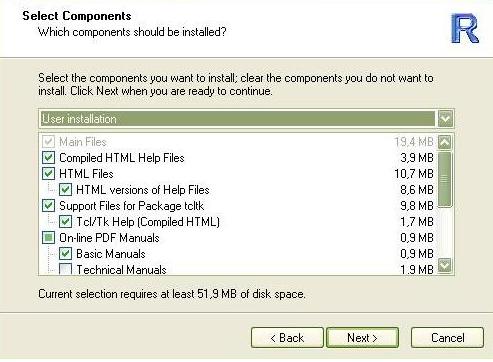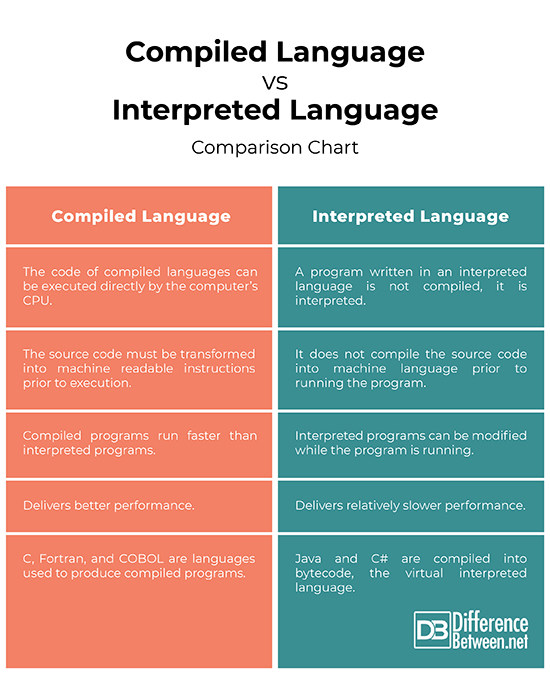Difference Between Compiled and Interpreted Language
Programming languages generally fall into one of the two types of languages – compiled languages or interpreted languages. However, the difference is not in the language; it’s in the implementation. It’s not wrong to say that both are the properties of the implementation of a language, but not the properties of the language itself. Implementing a programming language means bridging the gap from the high-level thinking of the programmer to the zeroes and ones of the machine. If done efficiently, programmers can concentrate on the actual problems, rather than on the details of machines. So, a programming language can be compiled or interpreted based on the implementation.
Well, both types of programming languages have their strengths. Some languages require all your code to be compiled before any of the code can be executed. Other languages interpret each instruction at the time the code is executed. In fact, compiled languages are generally compiled by a programmer on the programmer’s computer; when the programmer shares the software, he/she shares the compiled 0’s and 1’s, but not the source code. However, with an interpreted language, the code is saved in the same format you entered and must be translated at run-time. Let’s take a look at a detailed comparison between compiled and interpreted languages.

What is a Compiled Language?
Computers are only capable of executing machine language, which is the language of the central processing unit (CPU) and is very simple. The goal of any programming language implementation is to translate a source program into the machine language so it can be executed by the CPU. All language implementations translate a source program into some intermediate representation before translating the intermediate representation to machine language. The most direct method of translating a program to machine language is called compilation. A program written in a compiled language must be converted into a different format before it is run. The source code must be transformed into machine readable instructions prior to execution. In short, the languages whose implementations are typically compilers and not interpreters are called compiled languages.

What is an Interpreted Language?
An interpreter is a program that is written in some other language and compiled into machine readable language. The interpreter itself is the machine language program and is written to read source programs from the interpreted language and interpret them. An interpreted language, on the contrary, does not compile the source code into machine language prior to running the program. It merely interprets the code on the fly. So, you don’t get the benefits or drawbacks of compilation errors. Interpreted languages require a piece of software called an interpreter, which takes the source code and executes one instruction at a time. When you run an interpreted source program, you actually run the interpreter. The interpreter is the machine language program that executes all the programs you write in the interpreted language.
Difference between Compiled and Interpreted Language
Basics of Compiled and Interpreted Language
– A program written in a compiled language must be converted into a different format before it is run. The source code must be transformed into machine readable instructions prior to execution. An interpreted language, on the contrary, does not compile the source code into machine language prior to running the program. It merely interprets the code on the fly. Interpreted languages require a piece of software called an interpreter, which takes the source code and executes one instruction at a time.
Compiler vs. Interpreter
– With compiled languages, there are at least two steps to get from source code to execution, while with interpreted languages, there is only one – execution. A program written in an interpreted language is not compiled – it is interpreted by another program while it runs. A program written in a compiled language goes through a process to change it from its human-readable text format into a machine-readable format. A program called a compiler makes this transition.
Usability
– Compiled programs run faster than interpreted programs, but interpreted programs can be modified while the program is running. This makes interpreted programs ideal for writing live performance software. Working with compiled languages can be nice because many bugs are found when source code is compiled. These bugs, called compilation errors prevent the code from compiling. On the contrary, interpreted languages are not compiled, so you don’t get the benefits or drawbacks of compilation errors.
Debugging
– With interpreted languages, all the debugging occurs at run-time. There is no compilation step during which you can cast out all the syntax errors in your code; instead you have to run the program to find any errors in it. This becomes a problem when you interpreted program modifies files, or makes any changes to permanent resources. This makes some bugs harder to catch because the code does not need to compile. Interpreted languages also present some security concerns in the online environment as malicious code can be injected mid-execution.
Compiled Language vs. Interpreted Language: Comparison Chart

Summary of Compiled vs. Interpreted Language
In a nutshell, both compiled and interpreted languages have their strengths. Some languages require all your code to be compiled before any of the code can be executed. Other languages interpret each instruction at the time the code is executed. The main difference between the two is that there are at least two steps to get from source code to execution with compiled languages. However, with interpreted languages, there’s only one step – execution. Compiled programs run faster than interpreted programs, but interpreted programs can be modified while the program is running.
- Difference Between Caucus and Primary - June 18, 2024
- Difference Between PPO and POS - May 30, 2024
- Difference Between RFID and NFC - May 28, 2024
Search DifferenceBetween.net :
1 Comment
Leave a Response
References :
[0]Lee, Kent D. Foundations of Programming Languages. Berlin: Springer, 2015. Print
[1]Reas, Casey and Ben Fry. Processing: A Programming Handbook for Visual Designers and Artists. Cambridge: MIT Press, 2014. Print
[2]Ciesla, Robert. Mostly Codeless Game Development. New York City: Apress, 2017. Print
[3]Colburn, Rafe. Sams Teach Yourself CGI in 24 Hours. Indianapolis: Sams Publishing, 2002. Print
[4]Image credit: https://commons.wikimedia.org/wiki/File:Algorithms_v.s._Programming_Languages.jpg
[5]Image credit: https://commons.wikimedia.org/wiki/File:R_setup1.JPG

Any computer expert here?